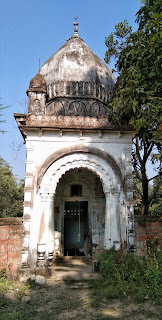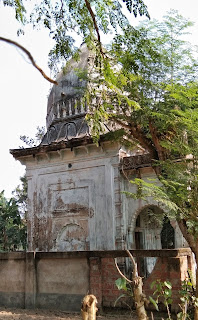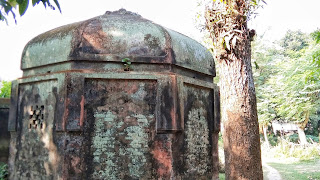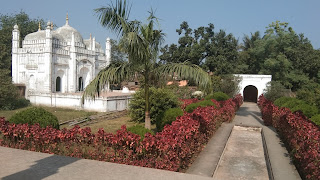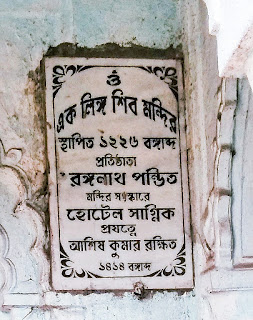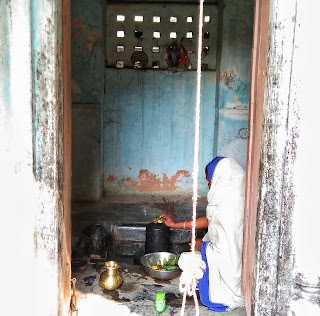The Ek-Linga Shiva Mandir inside Roshni Bagh which contains the tomb of Suja-Ud-Din Mohammad Khan.
The Shiva Mandir side view.
After ascending the throne of Bengal post the death of Murshid Kuli Khan, Shuja-ud-Din Mohammad Khan or Shuja-ud-Daula went on to convert entire Bengal to Islam. He was an ultra-conservative Muslim with a relatively polished tongue compared to his father in-law Murshid Kuli. Shuja was shrewd and firm but educated and eloquent. He began an era of Islamic development in Bengal in the 1700s. What Islamic rulers understood by development was conversion of existing Hindu monuments to Islamic monuments or building mosques on Hindu temple sites after demolition of the said temples. There have even been examples of Temple parts or construction materials from Hindu monuments being used in Islamic buildings. But since Shuja-ud-Daula was a sweet talking Bengali Aurangzeb, he did not take the path of destruction. He chose to deface and convert the existing Hindu structures. Roshni Bagh is a prime example of that, where a temple complex was converted in to a masjid and tomb.
However, the Ek-Linga Shiva mandir was left to be just like Murshid Kuli let the Shiva temple stand in Katra. It is heard that after the death of Shuja-ud-Daula, a Maratha Borgi senapati named Bhaskar Pandit had worshipped at this temple and had donated some his loot for the preservation of this temple. Since then his family’s name has been attributed to this temple. It is heard that Bhaskar Pandit’s descendants still come to visit this temple during Mahashivaratri.
During Shuja-Ud-Din conversion of the devi temple, since the Shiva temple was much in the corner, a low wall was built around it to keep it further out of sight and separate from the main complex which was now an Islamic complex known as Roshni Bagh. There is another temple that was left as it is just opposite to the EkaLinga Shiva Mandir.
This is not uncommon in Devi temples, especially in Bengal. A Shakti temple or devi temple always has one or more Shiva temples. Even the Kiriteshwari temple in Murshidabad has several Shiva temples inside the temple complex. The current Roshni Bagh complex too was a devi temple complex with a devi temple (which is now the masjid), another place maybe containing the sacrificial alter (which is now the tomb) and a Shiva temple. The place was probably lit with diyas all over and it shone from afar, thus the name ‘Roshni’.
The other unknown temple inside Roshni Bagh complex, which is inaccessible now.
The main temple that was converted to a masjid. The Shiva temple is on the extreme right. (Not visible in image)
Plaque on the wall of the temple contains false information as this temple was not built in 1226 Bangabda (1820 CE) but well before the death of Shuja-Ud-Daula in 1739 CE. It is heard that somewhere between 1741-1750CE, a Maratha Borgi Senapati named Bhaskar Pandit had donated some of his loot for the preservation of this temple. It was rebuilt in 1820 by one his descendants Ranganath Pandit.
An elderly woman can be seen worshipping Lord Shiva as this is a live temple.
The Eka-Linga Shiva Mandir still stands as a sign of the undying sanatan dharma.
But it is mostly overlooked by the tourists, even the Hindu tourists. They prefer to tie handkerchiefs around their heads and pose as if performing the namaz for the camera, they light agarbattis in Shuja-ud-Daula’s tomb but do not drop a single penny in the ‘pranami’ box of the Shiva temple. They don’t even go that way.
“It’s only the Hindu women who light agarbattis in Shuja-ud-Daula’s tomb. Muslims barely do anything here nowadays.”
